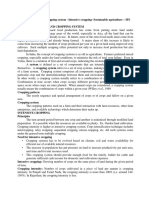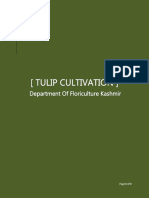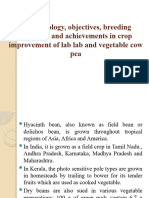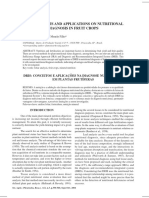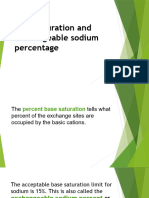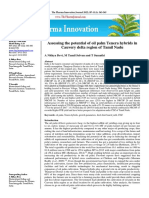0%(1)0% found this document useful (1 vote)
494 viewsCarrot and Radish
Carrot and Radish
Uploaded by
nithya1. Carrots can be classified based on their root shape or temperature response to flowering. Common shapes include long, half-long, and stump rooted. Temperate types require chilling for flowering while tropical types do not.
2. Popular carrot varieties include Nantes, Chantenay, Danvers, Early Nantes. Breeding objectives include high yield, carotene content, uniform roots, and disease resistance.
3. New varieties have been developed through hybridization and selection, such as Pusa Kesar, Pusa Yamdagni, and Pusa Rudhira.
Copyright:
© All Rights Reserved
Available Formats
Download as PPTX, PDF, TXT or read online from Scribd
Carrot and Radish
Carrot and Radish
Uploaded by
nithya0%(1)0% found this document useful (1 vote)
494 views35 pages1. Carrots can be classified based on their root shape or temperature response to flowering. Common shapes include long, half-long, and stump rooted. Temperate types require chilling for flowering while tropical types do not.
2. Popular carrot varieties include Nantes, Chantenay, Danvers, Early Nantes. Breeding objectives include high yield, carotene content, uniform roots, and disease resistance.
3. New varieties have been developed through hybridization and selection, such as Pusa Kesar, Pusa Yamdagni, and Pusa Rudhira.
Original Title
carrot and radish
Copyright
© © All Rights Reserved
Available Formats
PPTX, PDF, TXT or read online from Scribd
Share this document
Did you find this document useful?
Is this content inappropriate?
1. Carrots can be classified based on their root shape or temperature response to flowering. Common shapes include long, half-long, and stump rooted. Temperate types require chilling for flowering while tropical types do not.
2. Popular carrot varieties include Nantes, Chantenay, Danvers, Early Nantes. Breeding objectives include high yield, carotene content, uniform roots, and disease resistance.
3. New varieties have been developed through hybridization and selection, such as Pusa Kesar, Pusa Yamdagni, and Pusa Rudhira.
Copyright:
© All Rights Reserved
Available Formats
Download as PPTX, PDF, TXT or read online from Scribd
Download as pptx, pdf, or txt
0%(1)0% found this document useful (1 vote)
494 views35 pagesCarrot and Radish
Carrot and Radish
Uploaded by
nithya1. Carrots can be classified based on their root shape or temperature response to flowering. Common shapes include long, half-long, and stump rooted. Temperate types require chilling for flowering while tropical types do not.
2. Popular carrot varieties include Nantes, Chantenay, Danvers, Early Nantes. Breeding objectives include high yield, carotene content, uniform roots, and disease resistance.
3. New varieties have been developed through hybridization and selection, such as Pusa Kesar, Pusa Yamdagni, and Pusa Rudhira.
Copyright:
© All Rights Reserved
Available Formats
Download as PPTX, PDF, TXT or read online from Scribd
Download as pptx, pdf, or txt
You are on page 1of 35
Carrot and Radish
Carrot
Asiatic or tropical type carrot European Type or Temperate
Type carrot
1. Produce seeds in plains. 1. Produce seeds in hills
2. Do not require any low temperature 2. Requires chilling (4.8-10oC) for
treatment for flowering. flowering, resulting in its cultivation to
3. Long and red coloured roots with white hills.
or creamy core. 3. Medium and orange coloured roots
4. Rich in lycopene with centre core.
4. Rich in carotene
Pusa Yamdagini, Jeno, Imperator, Pusa Kesar, Pusa Meghali, Sel-333, No.
Chantaney, Danvers, Early Nantes, 29, Hisar Gairic, Pusa Rudhira, Pusa
Nantes, Nantes Half Long, Ooty, Solan Ashita
Rachna
• Important exotic types grown in India are
• Chantenay, Danvers, Nantes, Early Horn, Early Gem and Solan Rachna for their
long tapering roots and excellent quality.
• Chantenay and Danvers are known for their long tapering roots and
excellent quality.
• Early Horn and Early Gem are famous for their earliness and for their
mild flavoured roots.
• The carrot cultivars may be classified on the basis of shape of their
roots or on their temperature response to flowering.
• A. Classification based on shape of roots
1. Long rooted: Roots may be 25 cm or more in length, generally tapering,
generally perform best in comparatively light soil.
2. Half long rooted: Root length does not usually exceed 20 cm.
Roots cylindrical with straight or sloppy shoulder, e.g., Nantes
• Roots tapering with blunt or semi blunt tip, e.g. Chantenay, Imperator.
• 3. Short stump rooted: These cultivars are suitable for growing in heavy soils
Heart shaped. e.g. Oxheart
• Oval, e.g. Early Scarlet Horn
• Round, e.g., French Forcing
• A. Classification based on temperature response to flowering
Temperate or European or Biennial types: These cultivars are biennial in nature
and require low temperature (4.8-10oC) treatments for flowering to occur. These
do not produce seeds in the plains of India, e.g. Nantes, Chantenay, Imperator,
Danvers, Zeno, Ooty 1, Pusa Yamdagni etc.
• Tropical, Asiatic or Oriental or annual types: These cultivars do not require any
low temperature treatment for flowering. Seed freely in the plains of India.
Examples are Pusa Kesar, Pusa Meghali, Sel. No. 29 and Sel. No. 233.
BREEDING OBJECTIVES
• High root yield
• High carotene content in roots
• Uniformity in root shape and size
• Thick flesh roots
• Cylindrical, uniformly tapering or stump rooted carrot with non-branching habit
• Early rooting
• High sugar and dry matter in roots
• Slow bolting habit
• Smooth root surface
• Resistance to : Alternaria blight (Alternaria dauci), Cercospora leaf
spot(Cercospora carotae)
Introduction
• Zeno
• Early Nantes
• Nantes
• Nantes Half Long
• Imperator
• Chantenay
• Danvers
• Nantes
• Early Horn
• Early Gem
• Solan Rachna
• Nantes:
It is a European cultivar which can be grown both in hills and plains of India for
root production but set seed only in the hills after meeting the chilling
requirement.
• The roots are half long, slim, well shaped, cylindrical with stumped and forming a
small thin tail, deep orange red cortex and suitable for cultivation in cooler
months.
• Chantenay:
It is an excellent cultivar for canning and storage.
• Roots are 11-15cm long and 3-5cm in diameter with tapering to blunt end, deep
orange cortex and core.
• Royal Chantenay and Red Cored Chantenay are another cultivars belonging to this
group.
• Solan Rachna
• An open pollinated carrot variety which is a direct introduction from
Netherlands.
• It is long, smooth, orange coloured, self core variety with stumpy to
semi-stumpy roots(18-21 cm) .
• Rich in vitamin A content (15.14mg/100g)
• Early in maturity 100-108 days.
• Yields higher than Early Nantes
• Yield: 22.5-25.0 t/ha
Hybridization and selection
• Pusa Kesar:
This is a selection from a cross between Local Red and
Nantes Half Long.
• The roots develop on narrow central core which is also sufficiently
red coloured.
• It contains high amount of carotene (38mg/100g edible portion)
than Local Red (26mg/100g).
• The percentage of forked roots is lower than in Local Red and it
can tolerate higher temperature than Nantes.
• 90-110 days, 30 ton/ha
Hybridization and selection
• Pusa Yamdagni:
It is derived from the cross between EC 9981 (earliness) x Nantes Half
Long (self coloured core). It takes 86-130 days to produce harvestable
roots, which are long and orange and have a self-coloured core.
• Pusa Meghali – Nantes x Pusa Kesar
• Sel. 233 – Nantes x No. 29
• Rel. by PAU
• Desi type with good qualities of Nantes
• Resistant to cracking, bolting and forking
Pusa Rudhira 2008 It has self core red coloured with
delayed bolting. Maturity 85-90 days.
Average Yield 330 q/ha. Gives more
than 50% higher yield over check. Pusa
Kesar.
Pusa Asita 2008 It has self black coloured and is late
bolter. Maturity 95-100 days. Average
Yield 300 q/ha. Gives more than 30%
higher yield over check Pusa Kesar.
Pusa Vrishti 2009 It is a new heat tolerant tropical carrot
variety. It is suitable for early sowing
beginning in July under North Indian
plains. Maturity 85-90 days.
Average Yield 250 q/ha.
Pusa Vasuda 2012 First public sector tropical carrot hybrid
developed using CMS system. Self red
coloured carrot hybrid. High in total
carotenoids, lycopene, TSS and
minerals.
• Carrot - Arka Suraj
• Flowers and sets seeds under tropical condition. Deep orange roots
with self colour core. Smooth root surface. Conical shape. Root length
15-18 cm, root diameter 3-4 cm. TSS 8-10%. Carotene content 11.27
mg%. Tolerant to powdery mildew and nematodes.
• Radish - Arka Nishant
• Roots long, marble white in colour with crisp texture and mild
pungency. Resistant to pithiness, premature bolting, root branching
and forking. Yield 35-40 t/ha.
Carrot
1 Pusa Nayanjyoti 2009 Suitable for Yield : 35-40 t/ha
(Hybrid) cultivation First hybrid developed by Public Sector with orange colour roots. Roots are orange, smooth, uniform,
under low cylindrical, stumpy with small indistinct selfcoloured core. Roots possess high Bcarotene content (7.552
temperature mg/100g fresh weight). Sown in April-August in hills and in November-December in the Northern Indian
throughout Plains.
India.
2 Pusa Asita 2008 Delhi and NCR Yield : 25 t/ha
view image (SVRC, Long black roots with self coloured core, suitable for sowing from September to October. The roots are
Delhi) ready for harvest during December-January. Maturity in 90-110 days.
3 Pusa Rudhira 2008 Delhi and NCR Yield : 30 t/ha
view image (SVRC, Long red roots with self coloured core, triangular shape, suitable for sowing from mid-September to
Delhi) October The roots are ready for harvest from middle of December onwards.
4 Pusa Meghali 1994 Madhya Yield : 25 t/ha
view image (CVRC) Pradesh and Early; roots orange with self-coloured core; short tops. Only variety having orange coloured flesh in the
Maharashtra. tropical group. Produces seeds in the plains. Suitable for early sowing. Maturity in 100-120 days.
5 Nantes 1985 Throughout Yield : 12 t/ha
view image (CVRC) India Temperate type; small tops with green leaves; roots well shaped, small, orange, perfectly cylindrical,
abruptly ending in small thin tail, sweet and self coloured core with orange flesh.
6 Pusa Yamdagni 1985 Low Yield : 20-25 t/ha
temperature Roots long slightly tapering, cylindrical with small tops and o r a n g e c o l o u r roots. Sown in April-
conditions August in hills and in October-December in plains. Maturity 90-100 days after sowing.
throughout
India.
Carrot - Ooty – 1 (1997)
• This is a selection from half-sib progeny of a local type (D.C.3). The roots
are long and slightly tapering with attractive deep orange color.
• Suitable for growing in hilly areas at altitude above 1800m.
• The crop is medium in duration (100-110 days) and suitable for growing in
all the three seasons throughout the year.
• The central core is thin, fleshy and palatable.
• The crop is free from premature bolting and resistant to powdery mildew,
leaf spot and drought.
• The roots are rich in Beta-carotene.
• It yields 49.1 t/ha with a seed yield of 700-1000 kg/ha.
Resistance Breeding For Biotic Stress
• Nantes, Imperator: Res. To pythium spp.
• Vilmorium 66: Res. To Nematode.
• Virginia Savoy: Res. To CMV
• Scarlet, Nantes: Res. To Tip burn.
Spring radishes Winter radishes
Very common, rapid growing and quick Slow growing and late
maturing (20-30 days) maturing (50-90 days)
Relatively small roots Large roots
Root quality deteriorate quickly and mildly Stored better and have
pungent characteristic strong
flavour
Asiatic/tropical/subtropical type European/Temperate Type
Produce seeds in plains Seed production is limited to high hills
Pusa Desi, Pusa Reshmi, Pusa Chetki, Pusa Himani, White Icicle, Rapid Red White
Punjab Safed, Japanese White, Punjab Tipped, Scarlet Globe, Scarlet Long, Silver
Pasand, Arka Nishant, Chinese Pink, Queen, Kvarta (Short duration suitable for
Hisar Mooli No. 1, Kalyanpur No. 1, protected cultivation). French Breakfast, Palam
Kalyani White, CO-1, IPVR-I, IPVR-II, Hriday
C-2, Jaunpuri Mooli, Early Mino White
Breeding objective:
• •Early rooting
• •High yield
• •White, long/stump roots with thin tap root and non-branching habit
•Nonpithy roots
• •Pungency of roots as per consumers preference
• •Slow bolting habit
• •Heat tolerance
• •Drought resistance
• •Wet tolerance
• •Resistance to alternaria blight, white rust, RMV
• •Tolerance to aphids
• BREEDING METHODS:
• Introduction
• Mass selection: This is practiced in cultivars collected from the farmer’s
fields.
• Arka Nishant from IIHR.
• Pedigree method:
• Pusa Himani: Black Radish× Japanese White
• Pusa Rashmi: Green Top×Desi.
• Polyploid breeding: Polyploids with 2n=36 produced. No distict
advantages. Two polyploid varieties have been developed and these yields
more than diploids. 1.Sofia Delicious(2n=36) 2.Semi long Red Giant(2n=36).
• Radish contains an alkaloid isothiocyanate, good source of carbohydrates and minerals. Pink
colour of radish is due to the presence of anthocyanin and white colour varieties are not rich in
Vitamin-C.
• It is also grown for its young edible pods present in the species Rapahnus
caudatus besides Raphanus sativus
• There are two distinct groups viz. European or temperate and Asiatic or Tropical Types:
• European/ Temperate Type
They are quick growing and short duration type (25-30 days).
• Produce roots of good quality, less pungent and smaller in size.
• The important varieties belonging to this group are as follows:
White Icicle:
Roots cylindrical ending in a stump, 12-15cm long 2-3cm thick, skin slim, flesh white, mildly
pungent flavor, sweet and free from green top.
• Ready for harvesting in 25-30 days.
• Pusa Himani:
Roots are 30-35cm long, 10-12cm in length, skin is pure white and flesh is crisp and sweet
flavoured with mild pungency.
• Ready in 55 days for harvesting after sowing.
• Rapid Red White Tipped:
It is an early variety and produce short foliage.
• Roots are small, round and red in colour with green top foliage.
• Flesh is white, crisp and pungent.
• B. Asiatic or Tropical Type
Asiatic types don’t require chilling temperature for bolting and set seed freely under tropical conditions.
• Hence their seed can be produced under tropical conditions.
• The important varieties include:
Japanese White:
Roots are cylindrical ending in a stump and 25-30cm long.
• Flesh is pure white, crisp, smooth and mildly pungent, harvested 45 days after sowing.
• Produce seeds only in the hills and bolting is very less.
• Pusa Chetki:
Roots are medium sized, pure white, slim, mildly pungent and soft with blunt end.
• Roots become ready for harvesting in 40-45days after sowing.
• Pusa Reshmi:
Roots are 30-35cm long, white slightly green with tapering end.
• Roots mature in 55-60 days after sowing.
• Chinese Pink:
It has 12-15cm long pink coloured roots and lower end of roots is white.
• Roots are crisp and mildly pungent and mature in 50-55 days.
• Hisar Mooli No 1:
Developed by CCS, Haryana Agricultural University, Hisar.
• Roots are long, soft, white, straight and mature in 50-55 days
• Punjab Safed:
Roots are long (30-40 cm), thick (3-5 cm), pure white, tapering, smooth, mild in taste, medium pungent with
good flavour and free from forking.
Variety Year of States for which
S.No. Characterstics
Name Release Released
1 Pusa 2005 (SVRC, Throughout India Yield : 13.5 t/ha
Radish
Mridula
view
Delhi) Roots globular in shape, bright red in colour, size (2.9 x 4.1 cm),
white flesh with soft texture and mild pungent taste. Leaves
image dark green and tender. Maturity in 20-25 days after sowing.
Suitable for winter crop (September-February).
2 Pusa 1988 (CVRC) Throughout India Yield : 25 t/ha
Chetki Roots pure white, smooth, soft in texture, less pungent in
view summer sowings, 15-22 cm long, thick and stumpy; leaves
image entire, slightly lobed, dark green and upright. Maturity in 40-50
days, suitable for summer and rainy season (April-August).
3 Pusa 1979 Suitable for temperate, Yield : 30-40 t/ha
Chandrima sub-tropical and tropical Roots large round to flattish,white in colour with medium leaf
regions of north India. tops.Its outer skin is less deep and flesh white in colour.
4 Pusa 1979 Suitable for temperate, Yield : 35.5 t/ha
Swarnima sub-tropical and tropical Early maturing variety, medium leaf topps, roots flattish and
regions of north India. round. Its outer skin light yellow in colour. Suitable for planting
in June to October in hilly region and October to December in
plain. It matures in 60-70 days.
5 Pusa 1970 High and lower hilly Yield : 32.5 t/ha
Himani region. Roots are 30-35 cm long, thick, sharp non-stumpy end,
white with green top. Its flesh is pure white, crispy
with slightly pungent taste and sweet flavor. Maturity
55-60 days after sowing. Suitable for growing from
December to February in plains and foot hills and for
summer in medium to high altude area.
6 Japanese Higher and lower Yield : 25-30 t/ha
White hilly regions. Roots pure white, long and cylindrical; Maturity 60 days
after sowing.
7 Purple Suitable for Yield : 25-30 t/ha
Top temperate and Roots round shaped, top of root is purple and lower
White subtropical of north regions is white colour, Maturity 55-60 days.
Globe India.
Radish - Co-1 (1981)
• It is a selection from germplasm type (RS 44). The crop duration
ranges from 40 to 45 days and hence suitable for cropping systems. It
yields 20-25 t/ha. The roots are milky white, long (22 cm) thick 12.5
cm girth) and each weighs 220 g. The roots contain 10.9 mg of
vitamin C per 100g and 1.20% crude fibre. This variety is suitable for
growing all the year round under different cropping systems. It bolts
and sets seeds in the plain and hence very easy for the farmers to
produce seeds themselves. Roots have better consumers' preference.
Top to ratio is 0.99
Pusa Mridula 2005 Roots are globular with bright red skin,
mildly pungent. Maturity 25 days.
Average Yield 130 q/ha.
Pusa Jamuni 2012 First purple fleshed unique trait
nutritionally rich radish variety. Distinct
advantage in root size, shape, yield and
consumer preference over the existing
varieties. Higher anthocyanins and
ascorbic acid.
Pusa Gulabi 2012 First entire pink fleshed unique trait
nutritional rich radish variety. Medium
root size, cylindrical shape, optimal yield
and consumer preference over the
existing varieties. High total carotenoids,
anthocyanins and optimal ascorbic acid.
• Resistance Breeding For Biotic Stress
• • Asmer Tip Top: Res. To insect Erioischia brassicae
• • Punjab Safed: Res. To Leaf spot.
• • Chinese Rose White: Res. To Downy Mildew.
• • Nerina: Res. To Mosaic Virus.
• • Summer Wonder: Res. To Black rot.
You might also like
- Wheat SpecificationsDocument4 pagesWheat SpecificationsSyed Saad HashmiNo ratings yet
- Agronomy of Field Crops-IIDocument114 pagesAgronomy of Field Crops-IIVishal ShuklaNo ratings yet
- Fundamentals of Crop PhysiologyDocument1 pageFundamentals of Crop PhysiologyNk RahulNo ratings yet
- Listado de Normas AocsDocument10 pagesListado de Normas AocsJosé Nemo Di Natale0% (1)
- Cropping Pattern and Cropping SystemDocument4 pagesCropping Pattern and Cropping SystemRohit GuptaNo ratings yet
- Tulip CultivationDocument10 pagesTulip CultivationSofi MehrajNo ratings yet
- Floral Biology, Objectives, Breeding Strategies and Achievements in Crop Improvement of MarigoldDocument25 pagesFloral Biology, Objectives, Breeding Strategies and Achievements in Crop Improvement of MarigoldnithyaNo ratings yet
- Physiology of DormancyDocument18 pagesPhysiology of DormancyAnonymous fbUJwFVPNo ratings yet
- VSC 301 - Lablab and Cowpea - PPT 1 - Agri JunctionDocument62 pagesVSC 301 - Lablab and Cowpea - PPT 1 - Agri Junctionsivakarthikkeyen321No ratings yet
- Olericulture PPT FinalDocument23 pagesOlericulture PPT FinalAnonymous GGL7k0PWNo ratings yet
- Hort 232 Practical ExamDocument1 pageHort 232 Practical ExamVikki Nandeshwar100% (2)
- Hopkins4e PPT ch4Document57 pagesHopkins4e PPT ch4api-355298421No ratings yet
- 18 JuteDocument19 pages18 JuteMamata khandappagolNo ratings yet
- SapotaDocument17 pagesSapotaKishu KishorNo ratings yet
- PeanutDocument63 pagesPeanutmalath bashNo ratings yet
- Soybean - 28 03 2017Document20 pagesSoybean - 28 03 201724 ChannelNo ratings yet
- Dragon Fruit Growth and DevelopmentDocument6 pagesDragon Fruit Growth and DevelopmentEduardson JustoNo ratings yet
- Soil OrganismsDocument4 pagesSoil Organismstibau4No ratings yet
- Potatoes: Nutritional Recommendations ForDocument44 pagesPotatoes: Nutritional Recommendations ForNik NikNo ratings yet
- Sugarcane Cultivation and Primary ProcessingDocument51 pagesSugarcane Cultivation and Primary Processingcherrylyn celiz0% (1)
- OnionDocument36 pagesOnionM.P. Seenivasan100% (1)
- GPB 321 E-Compendium BhilwaraDocument90 pagesGPB 321 E-Compendium BhilwaraNk MeenaNo ratings yet
- Soil Biological PropertiesDocument27 pagesSoil Biological PropertiesFitri Abdul AzizNo ratings yet
- Integrated Disease ManagementDocument4 pagesIntegrated Disease ManagementShah PankajNo ratings yet
- Agriculture Waste ManagementDocument25 pagesAgriculture Waste ManagementRajesh KanzariyaNo ratings yet
- DRIS Concepts and Applications On Nutritional Diagnosis in Fruit CropsDocument11 pagesDRIS Concepts and Applications On Nutritional Diagnosis in Fruit CropsRómulo Del ValleNo ratings yet
- Effect of Pruning Technique On Growth and Yield of BrinjalDocument6 pagesEffect of Pruning Technique On Growth and Yield of BrinjalHasan MehrajNo ratings yet
- AGRONOMY Book For Ibps AfoDocument37 pagesAGRONOMY Book For Ibps Afosuraj kumar singhNo ratings yet
- Experiment 2: Growth and Development Title: Structure of Seed ObjectivesDocument5 pagesExperiment 2: Growth and Development Title: Structure of Seed ObjectivesValentinoDullSatinNo ratings yet
- Study On Identification of Weeds and Weed Seeds PropagulesDocument9 pagesStudy On Identification of Weeds and Weed Seeds PropagulesrahnokibNo ratings yet
- Chapter 1 - Introduction Definition and Classification of NutrientsDocument3 pagesChapter 1 - Introduction Definition and Classification of NutrientsDaniele ReisNo ratings yet
- My Rawe's ProjectDocument63 pagesMy Rawe's ProjectSamuel DavisNo ratings yet
- Bachelor of Science in AgroforestryDocument1 pageBachelor of Science in AgroforestryFrancis PeritoNo ratings yet
- Common Crop Diseases From Plant ReviewerDocument1 pageCommon Crop Diseases From Plant ReviewerJESRYL PAULITENo ratings yet
- Introduction To Rice, Cereals and PulsesDocument16 pagesIntroduction To Rice, Cereals and PulsesSimrat Bagga100% (3)
- Field CropsDocument215 pagesField CropsGary Bhullar100% (2)
- Agr 154 C1Document28 pagesAgr 154 C1Fatin Aisyah SulaimanNo ratings yet
- 7.TOMATO PPT - 0Document22 pages7.TOMATO PPT - 0Senthil MuruganNo ratings yet
- Peanut 2Document99 pagesPeanut 2Raven May OngayoNo ratings yet
- Cereal Based Cropping System in IndiaDocument20 pagesCereal Based Cropping System in IndiaNicholas Cooper100% (1)
- B.sc. (Agriculture) Horticulture Part-III (Semester V & VI)Document31 pagesB.sc. (Agriculture) Horticulture Part-III (Semester V & VI)gur jazzNo ratings yet
- DISEASES OF FIELD AND HORTICULTURAL CROPS AND THEIR MANAGEMENT-II RevDocument36 pagesDISEASES OF FIELD AND HORTICULTURAL CROPS AND THEIR MANAGEMENT-II RevTaushif AhammedNo ratings yet
- AET-301-Pests of Crops and Stored Grain and Thier ManagementDocument158 pagesAET-301-Pests of Crops and Stored Grain and Thier ManagementAvinash S MNo ratings yet
- Cropping Systems in Vegetables: R.P. Singh, Padmaja Pande, S.S. Solankey and Antra ChatterjeeDocument27 pagesCropping Systems in Vegetables: R.P. Singh, Padmaja Pande, S.S. Solankey and Antra ChatterjeeBasiru IbrahimNo ratings yet
- Unit V - Economic Botany NotesDocument9 pagesUnit V - Economic Botany NotesJayanthi PNo ratings yet
- Bioinformatics PPT Section B Data Storage and Retrival Group 3Document36 pagesBioinformatics PPT Section B Data Storage and Retrival Group 3seretbarakiNo ratings yet
- Ragone 2008 Breadfruit Regeneration IPGRIDocument7 pagesRagone 2008 Breadfruit Regeneration IPGRISitiSyarahNP100% (1)
- 2020 Micropropagation of Medicinal Plants - Review Micropropagation of Medicinal Plants - ReviewDocument8 pages2020 Micropropagation of Medicinal Plants - Review Micropropagation of Medicinal Plants - ReviewMuhilan MahendhiranNo ratings yet
- Base Saturation and Exchangeable PercentageDocument9 pagesBase Saturation and Exchangeable Percentagemariellamahilum2003No ratings yet
- Plant Nutrition: 16 Essential Nutrients For Normal Plant GrowthDocument14 pagesPlant Nutrition: 16 Essential Nutrients For Normal Plant GrowthKleng Delos Santos BernardoNo ratings yet
- Crop Production Technology - Kharif CropsDocument32 pagesCrop Production Technology - Kharif CropsAKSHAY THOTTUVANo ratings yet
- Importance, Scope and Problems of Vegetable ProductionDocument20 pagesImportance, Scope and Problems of Vegetable ProductionVani B0% (1)
- CeleryDocument16 pagesCeleryNitika100% (1)
- Lecture - 2PRAMOD RAIDocument52 pagesLecture - 2PRAMOD RAIrahulNo ratings yet
- Curry Leaves Farming Guide Curry Leaf CultivationDocument2 pagesCurry Leaves Farming Guide Curry Leaf CultivationMoolam RaoNo ratings yet
- Effect of Temperature On Crop ProductionDocument14 pagesEffect of Temperature On Crop ProductionKashif Akram100% (1)
- PBG 301 First Half NotesDocument79 pagesPBG 301 First Half NotesUnknownAuthorNo ratings yet
- Seed TechnologyDocument11 pagesSeed TechnologyristiyaadiwiratamaNo ratings yet
- Canopy Management in PomegranateDocument7 pagesCanopy Management in PomegranateAbhishekpNo ratings yet
- Factors Affecting Juvenility and Growth of A VegetativeDocument33 pagesFactors Affecting Juvenility and Growth of A VegetativeAlangelico Ortiz San PascualNo ratings yet
- Full Download Citrus Fruit: Biology, Technology, and Evaluation, 2nd Edition Milind Ladaniya PDFDocument57 pagesFull Download Citrus Fruit: Biology, Technology, and Evaluation, 2nd Edition Milind Ladaniya PDFanataumide53100% (2)
- Pests of Field Crops and Pastures: Identification and ControlFrom EverandPests of Field Crops and Pastures: Identification and ControlPT BaileyNo ratings yet
- Effect of Post-Harvest Dips and Packing Treatments On Shelf Life of Papaya (Carica Papaya L.)Document3 pagesEffect of Post-Harvest Dips and Packing Treatments On Shelf Life of Papaya (Carica Papaya L.)nithyaNo ratings yet
- Effect of Various Post-Harvest Treatments On Banana Cv. RasthaliDocument3 pagesEffect of Various Post-Harvest Treatments On Banana Cv. RasthalinithyaNo ratings yet
- Assessing The Potential of Oil Palm Tenera Hybrids in Cauvery Delta Region of Tamil NaduDocument3 pagesAssessing The Potential of Oil Palm Tenera Hybrids in Cauvery Delta Region of Tamil NadunithyaNo ratings yet
- Soil and Soil FormationDocument38 pagesSoil and Soil Formationapi-219521159No ratings yet
- Evaluation of Water Equality of Major Rivers in Palawan Using Physico-Chemical Parameters and Water Quality IndexDocument13 pagesEvaluation of Water Equality of Major Rivers in Palawan Using Physico-Chemical Parameters and Water Quality IndexMark Ian EspirituNo ratings yet
- Land Acquisition Case Law Digest CollectionsDocument28 pagesLand Acquisition Case Law Digest CollectionsSridhara babu. N - ಶ್ರೀಧರ ಬಾಬು. ಎನ್100% (4)
- Adobe or Sun-Dried Brick For Farm BuildingsDocument21 pagesAdobe or Sun-Dried Brick For Farm BuildingsAdobe PatrimonialNo ratings yet
- Notes For Land Laws - SomDocument70 pagesNotes For Land Laws - Somnaiksiddhant408No ratings yet
- Agrisnet FinalDocument12 pagesAgrisnet FinalAnandNo ratings yet
- 11-0.4kV designDocument19 pages11-0.4kV designprem.ucs2081No ratings yet
- LPM 121 FodderDocument133 pagesLPM 121 FodderHvk- 2062 Suhas C GNo ratings yet
- FeedlotDocument18 pagesFeedlotanimrajabiy0310No ratings yet
- CSP - LiFE Mission 75 PointsDocument4 pagesCSP - LiFE Mission 75 Pointssathishsunkara279No ratings yet
- Mobile SawsDocument2 pagesMobile SawsChristianGBNo ratings yet
- AssureWel Dairy Scoresheet - GenericDocument2 pagesAssureWel Dairy Scoresheet - GenericM ElmanavieanNo ratings yet
- Aeroponic For Vegetable Growing: TopicDocument13 pagesAeroponic For Vegetable Growing: TopicArslan Rao100% (1)
- Thiram in Oil Palm Nursery FateDocument7 pagesThiram in Oil Palm Nursery Fate李国振No ratings yet
- Tle9agricrop q2 m2 Cleaninguponcompletionofwork v2Document31 pagesTle9agricrop q2 m2 Cleaninguponcompletionofwork v2Bererly Curan GalenzogaNo ratings yet
- Meat and Live Animal Export in Ethiopia - Status, Challenges and OpportunitiesDocument6 pagesMeat and Live Animal Export in Ethiopia - Status, Challenges and Opportunitiesanwar18775% (4)
- Briefer On RA 10611Document1 pageBriefer On RA 10611Eugene UC100% (1)
- Plant CropsDocument18 pagesPlant CropsJamaica Jade MoredoNo ratings yet
- Farm Tools and ImplementDocument3 pagesFarm Tools and ImplementBadette ManaloNo ratings yet
- Rural MarketingDocument45 pagesRural MarketingPranav Thapar100% (1)
- Walmart Chicken Price Fixing ComplaintDocument98 pagesWalmart Chicken Price Fixing ComplaintmglennonexaminerNo ratings yet
- A La Carte Menu and Beverage Lists: MPDHM 170002Document11 pagesA La Carte Menu and Beverage Lists: MPDHM 170002Ngabo IldephonseNo ratings yet
- S.6 Geo FishingDocument28 pagesS.6 Geo FishingMale DaviesNo ratings yet
- Varanasi DDP Report FinalDocument119 pagesVaranasi DDP Report FinalAakanksha MishraNo ratings yet
- Threats To Endemic Squirrels in Philippines Biology JournalDocument3 pagesThreats To Endemic Squirrels in Philippines Biology JournaljulianaNo ratings yet
- Tree Diseases IDocument2 pagesTree Diseases Idwblakey100% (1)
- Processing Procedures of Brick Tea and Their Influence On Fluoride ContentDocument4 pagesProcessing Procedures of Brick Tea and Their Influence On Fluoride ContentikaredbutterflyNo ratings yet
- Ix - Social Science MsDocument6 pagesIx - Social Science Msriteshlenka313No ratings yet




